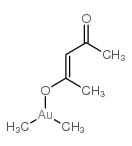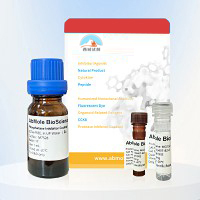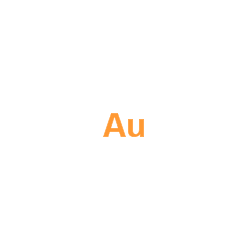二甲基(乙酰丙酮)金(III)(99.9%-Au), 99%,Dimethyl(acetylacetonate)gold(III)(99.9%-Au)
产品编号:西域试剂-WR379399| CAS NO:14951-50-9| MDL NO:MFCD01073806| 分子式:C7H13AuO2| 分子量:326.60
本网站销售的所有产品仅用于工业应用或者科学研究等非医疗目的,不可用于人类或动物的临床诊断或者治疗,非药用,非食用,
| 英文名称 | Dimethyl(acetylacetonate)gold(III)(99.9%-Au) |
|---|---|
| CAS编号 | 14951-50-9 |
| 产品熔点 | 81-82ºC |
| 产品沸点 | 25ºC 0,01mm |
| 精确质量 | 326.05800 |
| PSA | 26.30000 |
| LogP | 2.12520 |
| 稳定性 | 遵照规定使用和储存则不会分解。 |
| 储存条件 | 密闭于阴凉干燥环境中 |
相关文档
化学品安全说明书(MSDS)
下载MSDS质检证书(COA)
相关产品
| 风险声明 (欧洲) | 36/37/38 |
|---|---|
| 安全声明 (欧洲) | 26-36/37/39 |
| 海关编码 | 2918300090 |
|
Section 1: Product Identification Chemical Name:Dimethyl(acetylacetonate)gold (III), 98% (99.9%-Au) **MUST SHIP OVERNIGHT/DRY ICE** CAS Registry Number:14951-50-9 Formula:(CH3)2(C5H7O2)Au EINECS Number:None Chemical Family:metal alkyl Synonym:Dimethylgold (III) acetylacetonate; Dimethylgold (III) 2,5-pentanedionate
Section 2: Composition and Information on Ingredients IngredientCAS NumberPercentACGIH (TWA)OSHA (PEL) Title Compound14951-50-9100%no datano data Section 3: Hazards Identification May be irritating to skin, eyes, and respiratory tract. Exposure to gold compounds may damage kidney Emergency Overview: function and reduce blood cell count. Primary Routes of Exposure:Ingestion, inhalation, skin, eyes Eye Contact:May cause slight to mild irritation of the eyes. Skin Contact:May cause slight to mild irritation of the skin. Inhalation:Dust may be irritating to the nose, mucous membranes and respiratory tract. Ingestion may lead to dermatitis, dizziness, metallic taste, abdominal cramps, vomiting, bloody diarrhea, Ingestion: weakness, and convulsions. May cause irritation to the eyes, skin and respiratory tract, impairment of kidney and bone marrow function, Acute Health Affects: abdominal cramps, vomiting, bloody diarrhea, weakness, and convulsions. Chronic Health Affects:Prolonged exposure to gold compounds may lead to reduced red and white blood cell generation. NTP:No IARC:No OSHA:No SECTION 4: First Aid Measures Immediately flush the eyes with copious amounts of water for at least 10-15 minutes. A victim may need Eye Exposure: assistance in keeping their eye lids open. Get immediate medical attention. Wash the affected area with water. Remove contaminated clothes if necessary. Seek medical assistance if Skin Exposure: irritation persists. Remove the victim to fresh air. Closely monitor the victim for signs of respiratory problems, such as difficulty Inhalation: in breathing, coughing, wheezing, or pain. In such cases seek immediate medical assistance. Seek medical attention immediately. Keep the victim calm. Give the victim water (only if conscious). Induce Ingestion: vomiting only if directed by medical personnel. SECTION 5: Fire Fighting Measures Flash Point:not applicable Autoignition Temperature:none Explosion Limits:none Extinguishing Medium:none required If this product is involved in a fire, fire fighters should be equipped with a NIOSH approved positive pressure Special Fire Fighting Procedures: self- contained breathing apparatus and full protective clothing. Hazardous Combustion andIf involved in a fire this material may emit toxic fumes. Decomposion Products: Unusual Fire or Explosion Hazards: No unusual fire or explosion hazards. SECTION 6: Accidental Release Measures To avoid raising dust, small spills may be mixed with diatomaceous earth, sand, vermiculite, or other suitable Spill and Leak Procedures: inert material and swept up. SECTION 7: Handling and Storage Handling and Storage:Store under inert atmosphere in a tightly sealed container. Store cold. SECTION 8: Exposure Controls and Personal Protection Eye Protection:Always wear approved safety glasses when handling a chemical substance in the laboratory. Skin Protection:Wear protective clothing and gloves. Ventilation:Material may form a fine dust. Handle the material in an efficient fume hood. If ventilation is not available a respirator should be worn. The use of respirators requires a Respirator Respirator: Protection Program to be in compliance with 29 CFR 1910.134. Ventilation:Material may form a fine dust. Handle the material in an efficient fume hood. Additional Protection:No additional protection required. SECTION 9: Physical and Chemical Properties Color and Form:white to off-white xtl. Molecular Weight:326.6 Melting Point:81-82°C Boiling Point:subl. ~25°C/0.01mm Vapor Pressure:not applicable Specific Gravity:no data Odor:none Solubility in Water:insoluble SECTION 10: Stability and Reactivity Stability:(store cold) Hazardous Polymerization:no hazardous polymerization Conditions to Avoid:none Incompatibility:oxidizing agents and active metals Decomposition Products:carbon monoxide, carbon dioxide, and gold. SECTION 11: Toxicological Information RTECS Data:No information available in the RTECS files. Carcinogenic Effects:No data Mutagenic Effects:No data Tetratogenic Effects:No data SECTION 12: Ecological Information Ecological Information:No information available SECTION 13: Disposal Considerations Disposal:Dispose of according to local, state and federal regulations. SECTION 14: Transportation Shipping Name (CFR):Non-hazardous Hazard Class (CFR):NA Additional Hazard Class (CFR):NA Packaging Group (CFR):NA UN ID Number (CFR):NA Shipping Name (IATA):Non-hazardous Hazard Class (IATA):NA Additional Hazard Class (IATA):NA Packaging Group (IATA):NA UN ID Number (IATA):NA SECTION 15: Regulatory Information TSCA:Not listed in the TSCA inventory. SARA (Title 313):Title compound not listed. Second Ingredient:None SECTION 16 - ADDITIONAL INFORMATION N/A |
| 上游产品 0 | |
|---|---|
| 下游产品 1 | |









 浙公网安备 33010802013016号
浙公网安备 33010802013016号